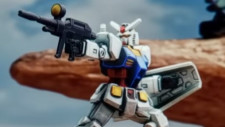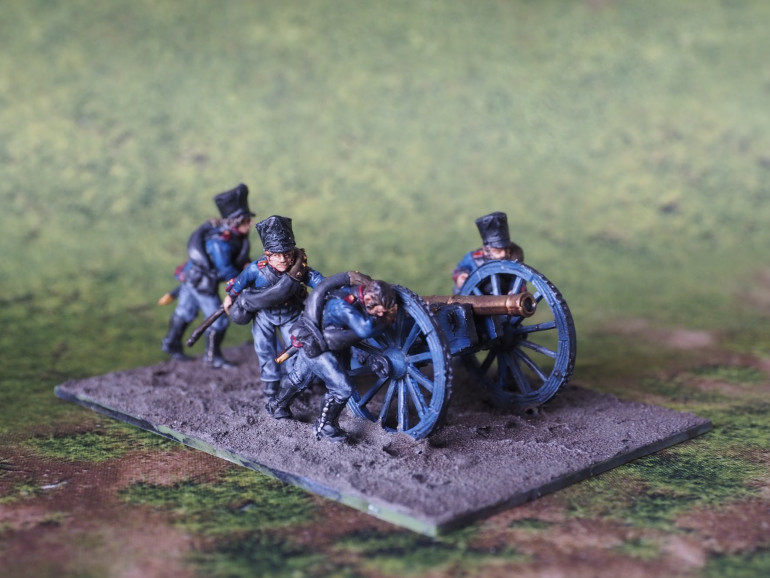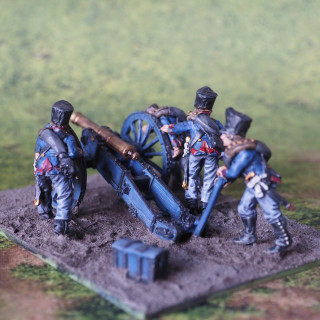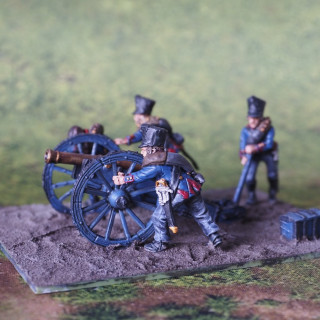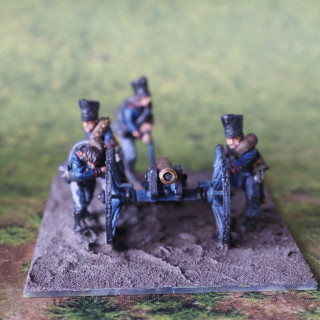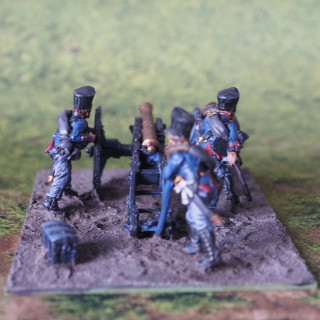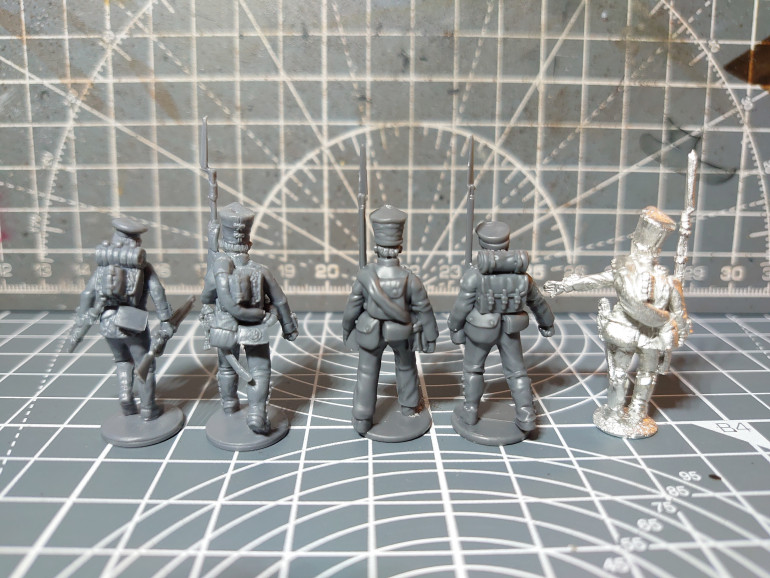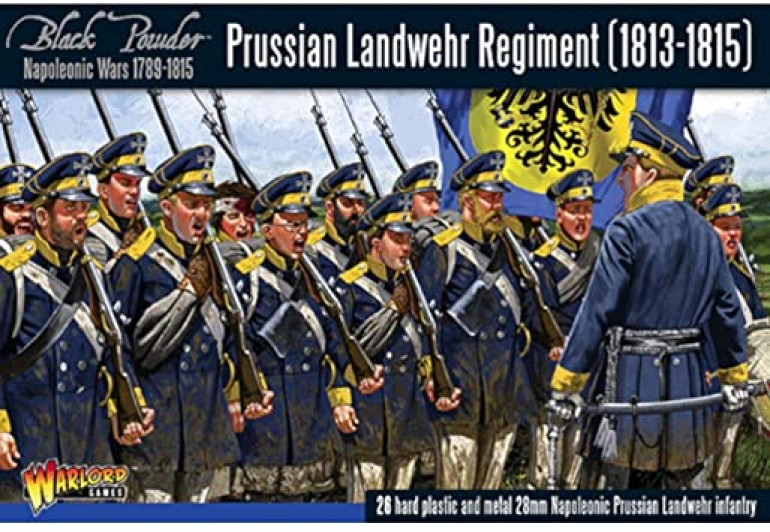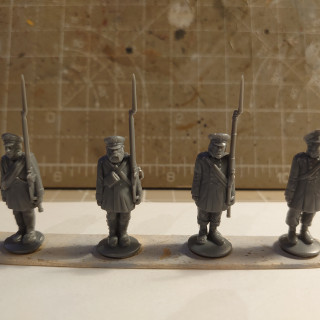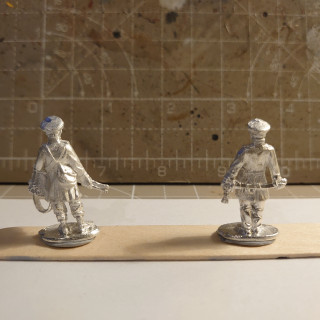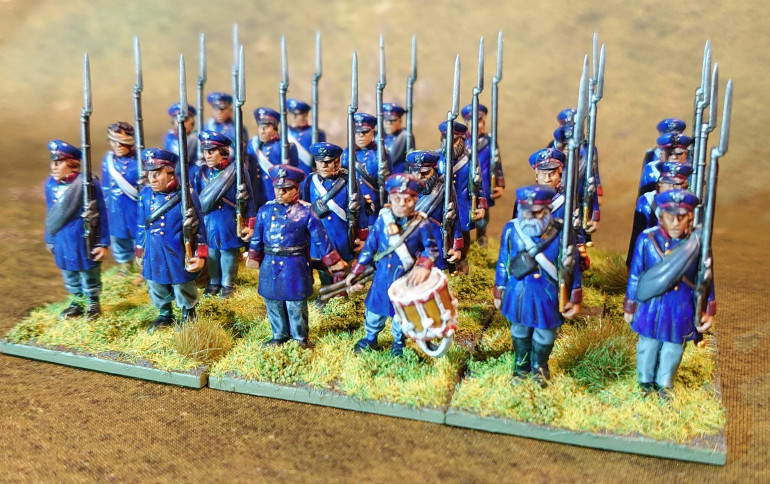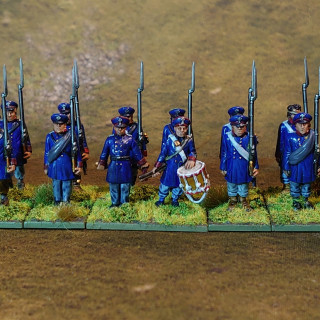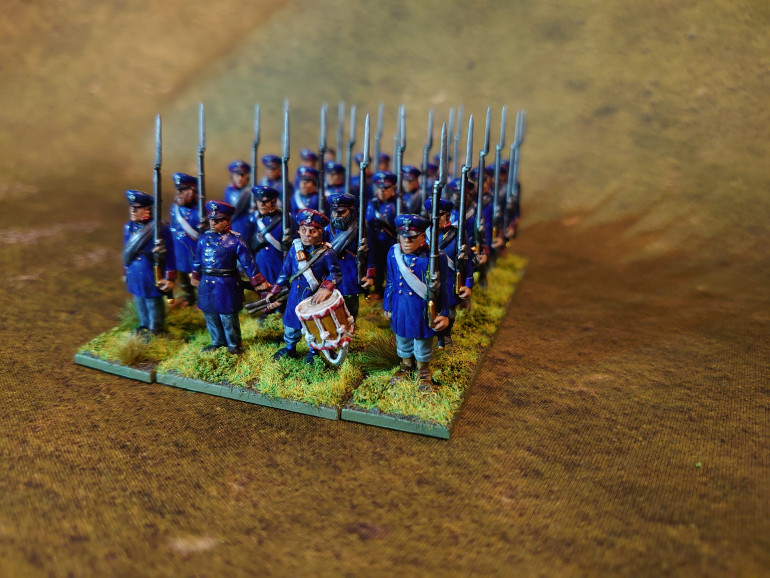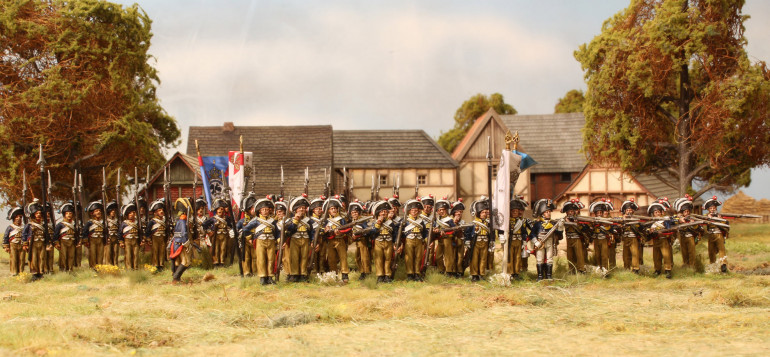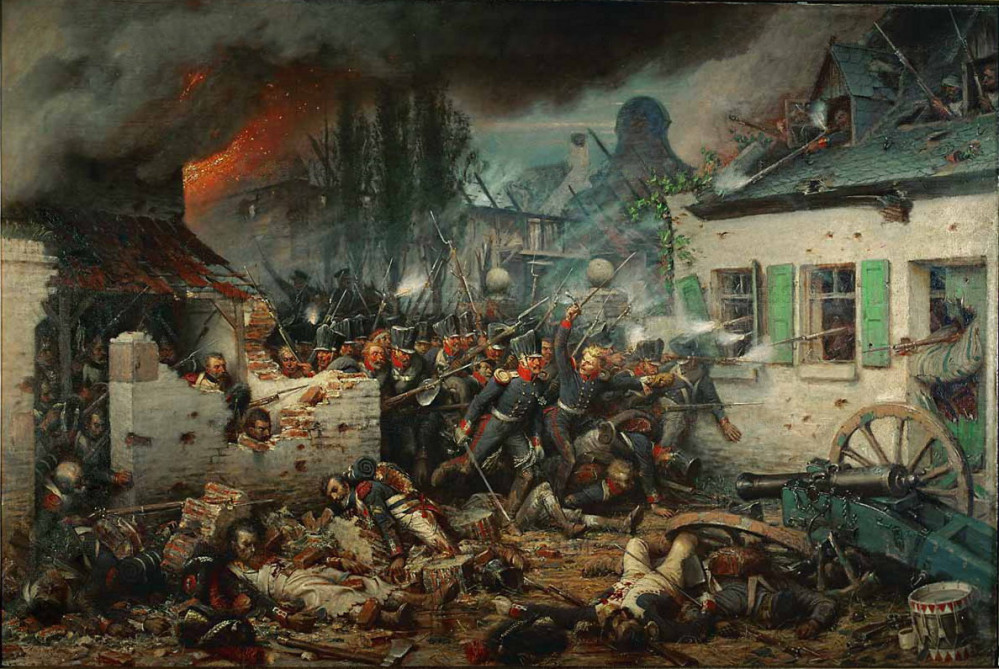
Raise high ze black flags my children! – The Prussian Army of 1813-1815
Recommendations: 886
About the Project
Building a 28mm Prussian Napoleonic army that can be used across a number of campaigns from 1813 upto the hurdred days and Waterloo.
Related Game: Black Powder
Related Company: Warlord Games
Related Genre: Historical
Related Contest: Spring Clean Hobby Challenge 2023
This Project is Active
Prussian Guns
I’ve finished the first artillery piece for my Prussian Napoleonic Army for Warlord Games Black Powder, Prussian Foot Artillery running up 6pdr by Perry Miniatures. I’m really happy with the results and managed to mix in a load of different painting techniques.
For assembly I Fixed the Cannon to the base, while painting the crew invidually.
First a zenith prime using Black and Grey Primer from Vallejo.
The Cannon was then airbrused using Vallejo Prussian Blue before a drybrush of Vallejo Dark Blue Grey, Citadel Corvus Black was then used for the metal work followed by a all round wash in Citadel Nuln Oil, For the gun I used Citadel Retributor Armour followed by a wash of Citadel Agrax Earthshade, a highlight of Vallejo Old Gold before a final light wash of Citadel Agrax Earthshade watered down.
The gun crew received the same prime and the sculpts by the Perry’s are absolutely fantastic and a joy to work with.
Again a mix of techniques starting with the main jacket experimenting with colour triads, a base of Vallejo Dark Sea Blue, followed by Vallejo Dark Prussian Blue and finall Vallejo Prussian Blue.
Citadel Contrast Black Template for the boots, Shakos and Belts, the trousers Citadel Contrast Space Wolves Grey which works fantastic with the sculpting and the zenith priming.
The greatcoat was a Basecoat of Vallejo London Grey followed by a wash of Citadel Nuln Oil in addition to Scale 75 Gobi Brown followed by a wash of Citadel Agrax Earthshade.
The flesh was again a mixture of techniques, Scale 75 Basic flesh, as wash of Citadel Rikeland Fleshshade, followed by highlights of Citadel Cadian Fleshtone and Citadel Kislev Flesh.
Based Using Vallejo Earth Texture, a brown wash followed by a drybrush of Vallejo German Camo Beige.
Wargames Atlantic Prussian Reserve (1813-1815)
A fantastic value kit from Wargames Atlantic, with some excellent sculpts. Each figure is 2/3 pieces, being the main body, head and a rolled greatcoat on some figures. You get a full range of head options, 6 shakos and 6 caps, so you can either have all of one or a mixture.
Minimal mould lines with some quick clean-up make these a joy to work with, detail is very well defined and they are a pleasure to paint up. My only critism would be that the eyes are pretty sunken and set back in the face.
Each box contains 60 Prussian Reservists, if your playing Black Powder and have battalions of the “standardish” size of 24 you have a few options on how you can create your units.
My recommendation would be to split the box into 3 groups of 20 and add a plastic Prussian command from the Perry’s, (£2 for 4 figrues). That gives you 3 Batallions worth for £31 (RRP and excluding postage costs) and uses every figure.
Rules wise Prussian Reserves are not covered in Black Powder, however Albion Trimuphant (vol 2) covers the Prussian army in 1815 for the 100 days campaign. By this point the reserve regiments had been converted into line regiments as such using these as regular Line would make the most sense, alternative you could class them as Landwehr.
As you can see these fits in almost perfectly with the Perry’s Prussian range, the sculpting style is different being digital but fit in scale and size well and dont look out of place.
I’ve got some more command figures on order from Front Rank and Calpe for some additional scale comparisons.
All round a fantastic kit from Wargames Atlantic, this leaves me hoping they will be doing more of these “Army Builder” Napoleonics.
A Review of Warlord Games Prussian Landwehr Regiment
Prussian Landwehr regiment 1813-1815
I picked up a pack of the Warlord Prussian Landwehr for £13 after some bargain hunting.
Overall, not a great set but for the price I can’t complain that much and they are certainly quick to assemble and paint, You interestingly get 26 figures, 24 plastics and 2 metal command, which is a bit of a odd number given most Warlord kits are 24 strong battalions.
The kits not up to some of the more modern sculpting standards and the figures feel quite hunched on the shoulders. The faces are perhaps the worst part, the spectacle wearing head is shockingly bad, and there’s also bandaged up head, overall you end up having to use these quite often. Surprisingly, this kit was released in 2017! The detail is reasonable but not fantastic for plastic.
The biggest let down is the metals, there’s very little definition in the detail, particularly the officers face, there also quite a bit shorter though they fit in reasonably well with the thickness of their bases, I believe this might be from their initial Prussian Range. They paint up reasonably well but either the sculpting wasn’t quick upto modern metals or the moulds seen its better days.
Competition wise these are the only plastic kit out, if your after Landwehr your going with this kit or metals. Therefore value for money these are excellent, as their is no direct competion on cost.
You do get a reasonably detailed leaflet included, with a fair amount of background on the Landwehr units including the colours worn (more in a future post) and a good range of potential flags to be used (again more in a future post).
I would give this a reasonable 7/10
Assembled Figures
Project Goals
Having recently got the Napoleonic bug and wanting a change from French I quickly decided I would like to start creating a Prussian force. Already having a few boxes of Prussians from Warlord Ga,es and a pre-order of Wargames Atlantics Prussian Reservists.
There’s two main choices for The Prussian Army of the Napoleonic Wars. The army of 1806 in all its splendour or the Army from the later 1813-15 campaigns (you could also count the force Prussia sent as part of the Grand Army’s invasion of Russia in 1812).
As I already have a few boxes of Landwehr and the Prussian Reservists I’ve already picked the later period, thankfully there’s a good selection of plastic kits too.
The Prussian Army upto 1806
Highly drilled and disciplined the Army at the start of the Napoleonic Wars was one of the most powerful and on paper skilled forces in Europe.
Unfortunately the Army of Fredrik the Great hadn’t really moved on, equipment was outdated and the same training and tactics from 40 years ago were still in use. Some early signs of this began to show at the Battle of Valmy and ultimately ended in the Battle of Jena–Auerstedt during the War of the Fourth Coalition where Davout’s III Corps (27,000) spectacularly beat the main Prussian force of (65,000) at Auerstedt while Napoleon was busy at Jena.
The resulting debacle and defeat left Prussian significantly weakened loosing land and becoming heavily indebted.
The reformed Army
Heavily shocked by this defeat reforms of state and of the army began, with Scharnhorst leading the military reforms. A reorganisation committee was formed and of 143 generals only two eventually remained, conscription was introduced and the officer corps was reopened to the middle class.
The Krümpersystem was introduced, seeing troops rotate from regular units into reserve formations allowing the Prussian Army to get around the limits enforce on them by the French following their defeat. Having a trained reserve provided the army with a more reliable backbone that could be called upon when needed, it being much easier to retrain a soldier that to train a soldier from scratch.
Prussian tactics also change moving away form the heavily drilled and displaced force into one emphasizing combined arms and the ability to march fast.
Following Napoleons retreat from Russia Prussian finally rejoined the war in 1813 as part of the Sixth Coalition, with the Army and reserves mobilising first in East Prussia, joined by the freshly raised Landwehr before this was replicated by the rest of the country.
Goals
I’ve a few goals I want to achieve with this Army build.
- Painting
- I want to experiment with some speed painting
- I also want to try and up my skill level, particularly with the more detailed units and characters.
- Try out some alternative painting methods, such as paint triads.
- Research
- Delve into the history of the Prussian Army of this period
- Dig into some of the uniforms and try and follow these as practically as possible, but not button count or become overly concerned.
- Build a Army
- Build a army that “historically accurate”, to the extend that units existed and are somewhat historically correct as a bit of a drive for the above research
- I don’t want to create an exact historical force
- I want to create a flexible and reusable force, that could be used in the 1813 campaigns or be equally as happy at waterloo
- Have a spring clear out of figures in boxes turning them into painted minis.
Perhaps most importantly of all I want to have fun along the way.




































